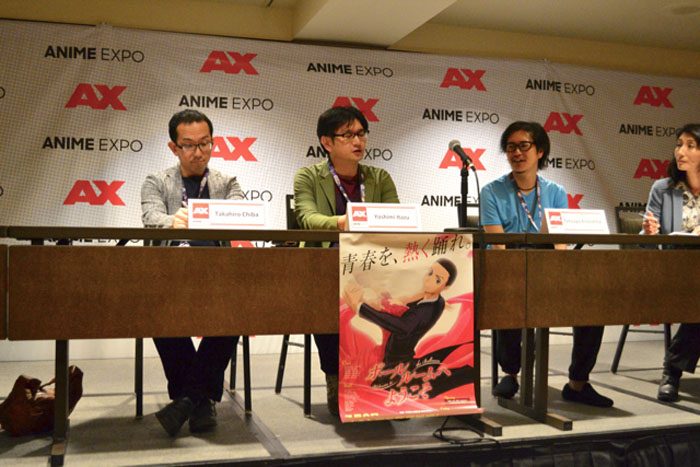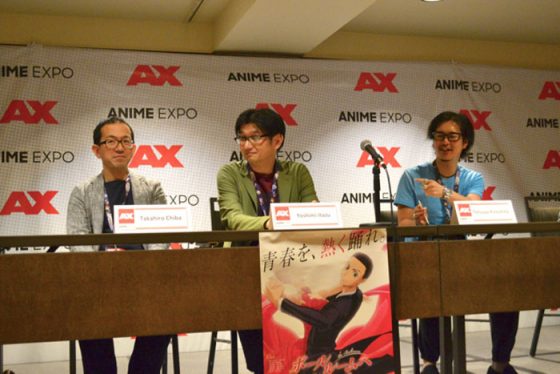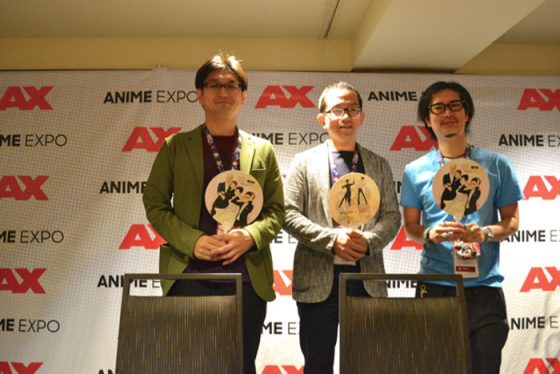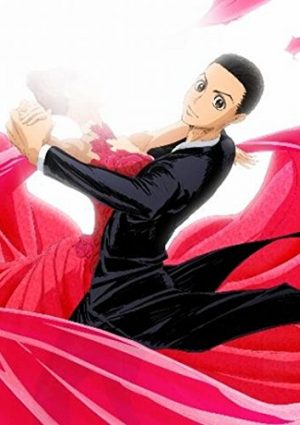
With the new sports anime, Welcome to the Ballroom (Ballroom e Youkoso) coming out this week, we were anxious to get to speak with its creators. Tetsuya Kinoshita is the producer for shounen hits like Attack on Titan, Sengoku Basara, and more recently, Yuki Yuna is a Hero, and is now the producer for Welcome to the Ballroom. With him, were the show’s director and animation director, Yoshimi Itazu and Takahiro Chiba, respectively. Itazu was an animator for The Wind Rises and Corpse Princess: Aka, and Chiba has been the animation director for hits like Haikyuu!! And Psycho-Pass. Here’s the knowledge they dropped on us.
Q1. If you could be anyone throughout history, besides yourself, who would you be?
Itazu: Hokusai. Hokusai Katsushika was a famous Ukiyoe painter, so I would like to be that because I am an animation director.
Kinoshita: Bill Gates! I want to be super rich.
Chiba: Walt Disney
Q2. Other sports anime like Free! and Yuri On ICE! have paid attention to athletes in their animation. For this project, have you taken steps to reference professional ballroom dancers?
Chiba: Yeah, I don’t really think too much about the professional ballroom dancers right now. This project is about the boy that’s becoming bigger.
Q3. Could you tell us a little about Welcome to the Ballroom and about Tatara, the main character of for the series, and why he decides to delve into the sport of ballroom dancing?
Itazu: So, the story is about a middle school boy named Tatara Fujita, and he doesn’t feel like he has very interesting characteristics or any talent at all. Then there is Tanami Sengoku, who is a talented ballroom dancer who, without Tatara knowing, Sengoku kind of pulled him into the ballroom sport. So, while Tatara is learning how to dance, he actually finds himself while doing that too, so that’s this project’s topic. With that, I also think that explains Tatara as well.
Q4. What do you feel are parts of the series that might inspire people to think that ballroom dancing is something fantastic and might make people want to take up ballroom dancing?
Itazu: In Japan, ballroom dancing is more social dancing and it’s more for middle-age to older generation folks. In this project, this animation, we are showing ballroom as athletic, it’s a sport, and so we’re watching all these characters being passionate about dancing and I hope that the younger generation in the world will be inspired to dance as well.
Q5. Kinoshita-san, Welcome to the Ballroom is very different from Shingeki no Kyoujin, Sengoku Basara, and Yuki Yuna in a Hero, how did you get involved in this project?
Kinoshita: I really seek stories that are interesting to me. Shingeki no Kyoujin has a character that is very interesting to me. He is a character that would overcome problems and it’s similar for the Masamune Date character. My keyword is passion. Welcome to the Ballroom has this ordinary boy overcome lots of obstacles and hurdles and that is my inspiration, why I wanted to produce this. I really like people that are really going through their hardships, having struggles, and watch them overcome them.
Q6. What was the decision behind choosing Shimba Tsuchiya as the lead seiyuu for this particular title, considering he’s relatively new and his only past experience was Haikyuu! and The Grudge?
Itazu: The main character, Tatara, matures throughout the story; and just like the character, we wanted to select a voice actor who is still fresh and exciting and attractive. That’s what we were were seeking in the actor and he was chosen.
Q7. About 20 years ago, there was a movie called Shall We Dance, which was remade in America, how has the stigma of ballroom dance changed since some people don’t appreciate the passion, in comparison to then [20 years ago] to now?
Itazu: Shall We Dance had main characters that were middle-aged, and for Welcome to the Ballroom, the main characters are all younger, so it is more athletic and competitive dance than social, which may be a difference where people are looking at ballroom dancing as not just a social activity, but now athletic as well, which is new in Japan.
Q8. What about director Yoshimi Itazu, appealed to you to select him as director for Welcome to the Ballroom?
Kinoshita: I actually got to know him through a Kodansha producer of Haikyuu!, Mrs. Matsushita, and after that, she said she wanted to work with Itazu-san and I was introducing him as Itazu-senpai, so after that, we decided to do it together. And I know he was also a super anime otaku for a long time. We should’ve expect it.
Q9. But this is his first TV anime that he is directing?!
Kinoshita: I just thought, you know, when you are fresh and it’s your first time, that you will dedicate your life to it [referencing that he would die for it], producing the best work.
Q10. Did you have any personal connection to ballroom dance? or was it a curiosity you wanted to explore, a topic that you're interested in?
Itazu: When I decided that I’d be working on this, I, of course, had to know what it was about and I was interested, so I did a lot of research; including taking a few classes.
Chiba: I had no idea about ballroom dancing, nor that it even existed. So, when I was getting involved, I started reading the manga and it was so amazing, which is why I got involved.
Kinoshita: We thought this manga was very nice, so we started planning right after that. And we don’t express the dancing in it, we express the boy’s life through dancing.
Q11. So dancing is like a catalyst?
Kinoshita: Yes.
Q12. How does ballroom dancing express the journey of your antagonist? Was there really something that you connected with your protagonist and allowed him to evolve?
Kinoshita: This is dance, but it is so athletic that Tatara himself probably didn’t know how much difficulty he would face when he started, so it is kind of unusual. So for myself, I was really attracted to that and the unusual story.
Q13. Why is Tatara’s growth such an important topic in relation to the anime? and why is it important that when watching or reading the manga we relate to Tatara and his growth?
Itazu: This manga was targeted towards boys and the youth and and when it comes to youth, we always have the growth and maturing of the characters as a topic, which is what most boys are interested in as well. Not just physically, but spiritually. And when it comes to dance, you might think it is just beautiful and easy, but actually, in Tatara’s experience it is very competitive and a lot of effort needs to be made and you also have to work together with a partner. This is another eye-opener for Tatara as well, realizing it’s not just you but you have to relate to that person or human being and that’s what we thought was beautiful.
Q14. Did you find yourselves in the same situation as Tatara when you were in school [Having trouble finding a passion]? If so, what was your ballroom dancing?
Kinoshita: I can say I had nothing like that in junior high school. That’s why now I’m making those kinds of animation.
Q15. So, would you say that is what attracted you to this story? Because you were like Tatara and didn’t find your “ballroom dancing” until later in life?
Kinoshita: Exactly!
Itazu: I’m the same. I couldn’t find anything in junior high school or high school.
Kinoshita: But you were already drawing!
Itazu: Oh, that’s right. I didn’t really have a social thing like ballroom dancing, but because I was drawing a lot when I was in high school, that’s why I am where I am right now.
Chiba: I do feel like I have a very strong connection to Tatara character-wise. When I was younger, I couldn’t really find myself. And I don’t think I’ve found anything yet.

Q16. Can we expect an extensive use of CG? Or is there more focus on hand-drawn animation?
Chiba: It’s all hand-drawn.
Q17. How is the music going to blend in with the animation? How were songs chosen?
Chiba: Competitive dance has several different categories, so we have to use music that is suitable for those categories, but we decided to have new music made for this anime, so we have custom-made music. We’re hoping that, from now on, maybe at some dancing competition, there will be some pairs that might be using our songs.
Kinoshita: Because we’re having a lot of original songs made, we are making the soundtrack, of course. Our soundtrack will contain 50% to 100% more than other regular anime soundtracks.
Q18. In the Welcome to the Ballroom trailer, we can see there are a lot of dynamic angles. What was Chiba-san’s thought process when choosing those angles and camera movements?
Chiba: We want our audience, the viewers, to feel the closeness of the dance. Not just being outside of the dance, but we’re trying to make you feel like you’re actually really close to the dancers. And we also want you to feel the heat coming off of these people dancing. So that’s the reasoning behind that kind of scene.
Kinoshita: It’s like this is kind of like an action anime. It is dance, but it’s really action. Kind of like Spider-man, it’s a treat to see that closeness, when you feel that Spider-man is right there. Just like Shingeki no Kyoujin, you feel the movements and speed and temperature. It’s a treat, in a sense.
Q19. Most sports anime have a very extreme way of showing the heat and passion in the sport. If Welcome to the Ballroom is a sport anime, how will ballroom dancing give that sports anime feeling?
Chiba: There’s never been an athletic ballroom dancing anime, so it’s a bit strange to have it as a sports anime, but on the other hand, I feel it’s very fresh and interesting.
Kinoshita: K: Maybe because Chiba-san has been involved with Haikyuu!!, some of the viewers might get a similar feel from this.Yuri on ICE!, I feel is too much boys love. But Welcome to the Ballroom is not boys love. It’s just his personal growth story, so it’s a little different.
Q20. One of the first anime to be released on Amazon, are you excited to release on a different kind of platform?
Kinoshita: Thi is a sports anime, but it’s different than most sport anime and we really wanted to show it to the world. So we are very excited that it will be on this different platform. But don’t worry, it won’t only be on Amazon.
Q21. We noticed Levi is in the promotional materials for Welcome to the Ballroom. Why was that decision made?
Kinoshita: I was also in charge of Attack on Titan and also the members of the production company are almost the same as Attack on Titan, also the same group and the same broadcasting time in Japan. So we just want to get Attack on Titan’s fans for Welcome to the Ballroom. It’s so business. But it’s fun!

Final Thoughts
This press conference was a sweet surprise at AX. It was all kept very hush-hush until the production team showed up, and boy was it a treat! Are you an Attack on Titan or Haikyuu!! fan who’s looking forward to checking out Production I.G.’s Welcome to the Ballroom?
We also got a chance to watch the first two episodes of Welcome to the Ballroom! So check out or review of that too!
Check out our other press conference coverage articles from AX 2017 for more fun stuff!
Nya~!
Recommended Post
Ballroom e Youkoso - Summer & Fall 2017
Recommended Post
Welcome to the Ballroom (Ballroom e Youkoso) Episodes 1 & 2 Review - A Sports Anime Like No Other From Seasoned Creators
Recommended Post


